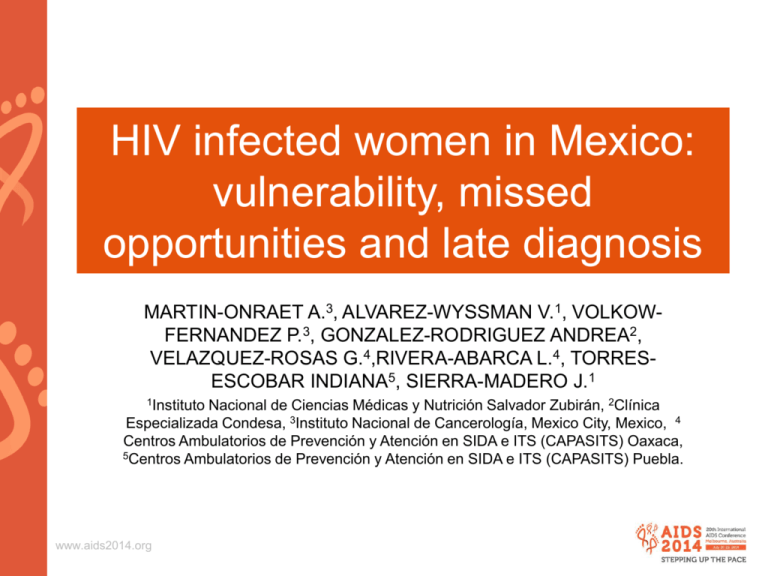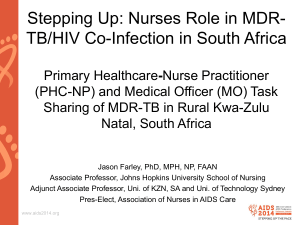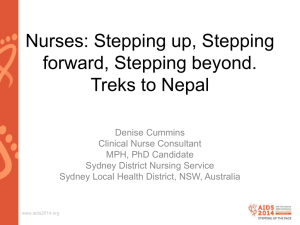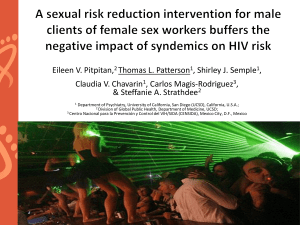
HIV infected women in Mexico:
vulnerability, missed
opportunities and late diagnosis
MARTIN-ONRAET A.3, ALVAREZ-WYSSMAN V.1, VOLKOWFERNANDEZ P.3, GONZALEZ-RODRIGUEZ ANDREA2,
VELAZQUEZ-ROSAS G.4,RIVERA-ABARCA L.4, TORRESESCOBAR INDIANA5, SIERRA-MADERO J.1
1Instituto
Nacional de Ciencias Médicas y Nutrición Salvador Zubirán, 2Clínica
Especializada Condesa, 3Instituto Nacional de Cancerología, Mexico City, Mexico, 4
Centros Ambulatorios de Prevención y Atención en SIDA e ITS (CAPASITS) Oaxaca,
5Centros Ambulatorios de Prevención y Atención en SIDA e ITS (CAPASITS) Puebla.
www.aids2014.org
INTRODUCTION
• HIV in Mexico is a concentrated epidemic driven by
infection in MSM
• Late presentation remains the most important
challenge
• Women represent 20% of affected population
• Detection campaigns focus on high risk groups that
do not include women
• The only screening strategy for HIV detection in
women is pregnancy
• HIV infected women are particularly vulnerable and
represent a double challenge
www.aids2014.org
GOALS
• What are the sociodemographic and clinical
characteristics of Mexican women recently
diagnosed with HIV infection?
• How are women diagnosed with HIV?
• Are there specific factors reflecting increased
vulnerability in women infected with HIV?
www.aids2014.org
STUDY DESIGN AND SAMPLE
SUBJECTS:
DATA:
Mexican
born
HIV-infected
women, diagnosed between 2009
and 2013, attending one of 4 HIV
care centers of 3 different states:
- Oaxaca
- Puebla
- Mexico City: Instituto de
Nutrición and Clínica Condesa
Structured face to face interviews
and medical records:
- Socio
demographics,
risk
behavior,
history
of
physical/sexual
violence,
circumstances
of
HIV
diagnosis and access to
medical and prenatal care
- Clinical information from files
• Standard statistical analysis was done with Stata 12.0
• Ethics approval was obtained, informed consent from women
• Women were offered legal and psychological counseling
www.aids2014.org
RESULTS
www.aids2014.org
SAMPLE
331 women invited
30 did not accept
270 women
interviewed
31 accepted file
review
301 women included
www.aids2014.org
HIV Care center, n=301
N (%)
Clínica Condesa
94 (31.2)
Instituto de Nutrición
58 (19.3)
Oaxaca
100 (33.2)
Puebla
49 (16.3)
SOCIODEMOGRAPHIC
CHARACTERISTICS
N(%)
Indigenous language:
- Speaks or understands
Education:
- illiterate
- Primary school (incomplete and complete)
- Secondary school (incomplete and complete)
- High school/commercial career/incomplete degree
- Complete degree
Participates in household income
Woman as the only provider for their family
Monthly income in USD:
- Less than 460 USD
www.aids2014.org
39 (14)
23 (7.7)
70 (23.6)
113 (38.1)
79 (26.6)
12 (4)
134 (50.1)
51 (19.1)
222 (94)
31%
31%
CLINICAL CHARACTERISTICS
Any comorbidity*
Co-infection HCV/HBV
History of alcohol abuse
History of illicit substance abuse
Initiation of sexual activity in years, median (range)
Number of pregnancies, median (range)
Number of sexual partners, median (range)
Age at first pregnancy, median (range)
First pregnancy at 18 years or less
Any sexually transmitted disease other than HIV at diagnosis:
- HPV infection
- Genital herpes
- Syphilis
- Other
*Diabetes Mellitus (5.3%), arterial hypertension (4.4%), dyslipidemia (14.3), others (7.7%)
www.aids2014.org
N (%)
58 (21)
6 (2)
33 (11.5)
31 (10.8)
17 (10-31)
2 (0-13)
2 (1-300)
20 (12-38)
63 (28.5)
82 (33.6)
61 (72.6)
7 (8.3)
5 (6)
11 (13.1)
VULNERABILITY FACTORS
a
History of physical violence at home :
N(%)
126 (47)
Who was the aggressor? a
- Previous or current partner
- Parents
- brother
- Others
97 (69.8)
22 (15.8)
4 (2.9)
16 (11.5)
History of sexual abuse:
¿Who was the aggressor? a
- Previous or current partner
- Parents
- brother
- Others
78 (29.7)
History of imprisonment:
History of living in the US or the borders
History of paid sex
11 (4)
16 (6)
26 (9.7)
There might be more than one agressor per woman
www.aids2014.org
35 (33.9)
5 (4.9)
12 (11.6)
51 (47.6)
Clinical and socio demographic
characteristics in different centers
Condesa
Nutrición
Oaxaca
Puebla
P
29 (30.8)
20 (34.5)
48 (48)
24 (49)
0.04**
Speaks or understands indigenous language, n (%) 8 (9.6)
4 (9.5)
25 (25.2)
2 (4.2)
0.001**
Number of sexual partners, median (range)
3 (1-300)
2 (1-40)
2 (1-99)
2 (1-45)
0.018*
History of paid sex, n (%)
12 (14.8)
1 (2.5)
9 (9.3)
4 (8.3)
NS
History of illicit substance use, n(%)
16 (18.8)
5 (9.4)
7 (7.2)
3 (6.12)
0.04**
History of sexual abuse, n (%)
32 (39)
14 (36)
20 (21)
12 (25.5)
0.04**
Baseline CD4 count, median (range)
217
111
298
194
<0.001*
(3-1341)
(1-913)
(14-1138)
(6-929)
Recently diagnosed partner or offspring
34 (42.5)
14 (35)
36 (36.3)
16 (33.3)
Symptoms
26 (32.5)
19 (47.5)
31 (31.3)
19 (39.6)
Pregnancy
8 (10)
1 (2.5)
16 (16.2)
4 (10.9)
Age at diagnosis <30 yo, n (%)
Reasons for diagnosis, n(%):
* Kwallis test, ** χ2 test
a There were statistical differences between INCMNSZ and Oaxaca, for diagnosis through pregnancy (p=0.02)
www.aids2014.org
NSa
SOURCE OF HIV INFECTION
N(%)
Likely source of infection:
- Stable partner (current or partner)
- I don’t know
- Casual partner
- Other reasons*
Had ever done an HIV test previously
Suspicion of being HIV infected before doing the test
- Of those who suspected, how many had done a test before
*
201 (75)
28 (10.5)
24 (9)
15 (5.5)
65 (24.3)
62 (23)
29 (46.7)
tatoo (1), rape (5), sharing needles (1), transfusion (5), working accident (3)
Reasons to get tested:
Health care provider recommendation
Other reasonsa
aTesting
www.aids2014.org
campaigns, donation, prenuptial studies, getting to a lab
N(%)
175 (65.3)
93 (34.7)
CIRCUMSTANCES OF HIV DIAGNOSIS
45
40
38.1
34.7
35
30
%
25
20
16.6
15
10.6
10
5
0
Infected
partner/offspring
(n=101)
www.aids2014.org
Symptoms (n=92)
Others (n=44)
Pregnancy (n=28)
CLINICAL STAGE AT PRESENTATION
Age at diagnosis, median (range)
CD4 count at presentation, median (range)
CD4<200 , n(%)
CD4 <100, n(%)
32 (16.5-75)
203 (1-1341)
133 (49.3)
77 (28.5)
AIDS defining events at diagnosis, n(%)
80 (27.5)
Number of AIDS defining events: 111 (there were more than one per patient)
Waisting syndrome (48), Cytomegalovirus disease (9), extrapulmonary tuberculosis (9), Candida
esophagitis (8), P.jiroveci pneumonia (8), atypical mycobacterial disease (3), pulmonary tuberculosis
(5), cryptococosis (3), others (18)
www.aids2014.org
MEDICAL CARE PRIOR TO DIAGNOSIS
Sought medical care for HIV
symptoms before diagnosis?*
Yes
Number of medical contacts prior to
HIV diagnosis
70
No
61
60
50
40%
%
40
30
20
60%
13.2
14.4
1-2
3-4
11.4
10
0
0
* Symptoms such as weight loss, fever, chronic
diarrhea, oral candidiasis, herpes
68% of women diagnosed through symptoms had sought
www.aids2014.org
medical care before
5 or more
Partner diagnosed
(n=83)
Median of CD4 267 (14-1341)
www.aids2014.org
(range)
Child diagnosed
(n=11)
Symptoms
(n=86)
Pregnancy
(n=20)
Others (n=40)
132 (30-659)
108 (1-726)
322 (6-1138)
198 (18-683)
# of medical contacts
None (n=141)
1-2 (n=34)
3-4 (n=35)
5 or more (n=26)
Median of CD4 (range)
256 (1-1341)
217 (7-1138)
187 (3-726)
31 (10-289)
www.aids2014.org
Characteristics associated to late stage
disease at diagnosis (CD4 count <200)
Univariate analysis
Multiplelogistic
regression
OR (CI95%)
CD4<200
CD4>=200
OR (CI95%)
<30 years
38 (36.5)
66 (63.5)
1
>= 30 years
95 (57.3)
71 (42.8)
2.32 (1.4-3.8)
Yes
5 (25)
15 (75)
1
No
Number of consultations prior to
diagnosis:
0-2
111 (50.4)
109 (49.6)
3 (1.07-8.6)
69 (39.4)
106 (60.6)
1
3 or more
44 (72.1)
17 (27.9)
3.97 (2.1-7.5)
P
P
Age at diagnosis:
1
0.001 1.89 (1.07-3.3)
0.02
Diagnosis through pregnancy:
1
0.02
1.8 (0.6-5.4)
1
<0.001 3.56 (1.85-6.8)
NS: Physical violence, sexual abuse, speaking indigenous language, illegal substance abuse,study degree
www.aids2014.org
0.2
<0.001
PRENATAL CARE
HIV test offered during prenatal care
70
61.2
60
50
%
40
30
20
11.6
13.6
All pregnancies
Some pregnancies
13.6
10
0
www.aids2014.org
None of the
pregnancies
Not applicable
CONCLUSIONS
• Women recently diagnosed with HIV in Mexico have
vulnerability factors such as a high prevalence of physical and
sexual violence, low level of education, pregnancies at young
age, low incomes and acquiring HIV mainly through their stable
partner
• Women are detected late, except for women diagnosed
through pregnancy
• Most women (73%) are diagnosed because of an infected
partner/offspring or being symptomatic
• Missed opportunities of earlier diagnosis and low rates of HIV
testing were detected, during medical and prenatal care
www.aids2014.org
Consequences and perspectives
• Late diagnosis in women seems to be the result of a
deficient health care system and lack of risk
perception both from health care workers and
women, in a context of high vulnerability and the
absence of screening policies for non-pregnant
women
• Strategies for early detection need to be reevaluated
for women in countries with concentrated epidemics
such as the one in Mexico
www.aids2014.org
ACKNOWLEDGMENTS
•
Instituto Nacional de
Médicas y Nutrición
Zubirán:
–
–
–
–
–
•
Ciencias
Salvador
Juan Sierra Madero
María de Lourdes Guerrero Almeida
Juan Calva Mercado
Brenda Crabtree Ramírez
Rigoberto Aramburo García
Clínica Especializada Condesa:
–
–
–
–
–
–
–
Andrea González Rodríguez
Jesús Casillas Rodríguez
Carlos Magis Rodríguez
Florentino Badial Hernández
Ubaldo Ramos Alamillo
Victoria Alvarez Wyssmann
Ricardo Niño Vargas
www.aids2014.org
•
Instituto Nacional de Cancerología:
– Patricia Volkow Fernández
– Diana Vilar Compte
•
Hospital general Manuel Gea
González
– Rafael Valdez Vázquez
– Patricia Rodriguez Zulueta
– Daniel Aguilar Zapata
•
CAPASITS Oaxaca
– Gabriela Velázquez Rosas
– Lesvia Rivera Abarca
– Yuko Nakamura López
•
CAPASITS Puebla
– Indiana Torres Escobar
– Tayde Pérez reyes







